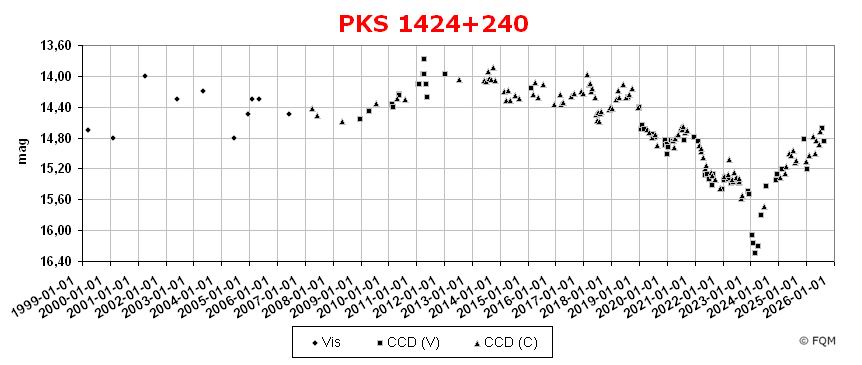
| Frankfurt Quasar Monitoring |
| PKS 1424+240 |
| Cross-Identifications |
PG
1424+240, TXS 1424+240, B2 1424+24, OQ+240 KUV 14247+2401, 7C 1424+2401, QSO B1424+240 PKS 1424+240, RGB J1427+238, 2E 1424.7+2401 SDSS J142700.39+234800.0, GB6 B1424+2401 FBQS J142700.4+234800, RX J1427.0+2348 0FGL J1427.1+2347, RBS 1395, 1424+240 |
| Equat. coordinates | RA 14 27 00.5 DE +23 48 00 (J2000) |
| Constellation | Bootes |
| Type | BL Lac |
| Redshift | z=0.160 (2) / z>0.603 (5) |
|
Distance
(2) (3) |
638
Mpc |
| Total mag range (mv) (4) | 14.0 - 18.39 |
| Catalog Magnitude (1) | 14.28 |
| Absolute Magnitude (1) | --- |
| Light Travel-Time |
1.930
× 109 yrs
(2)
/ >5.5 × 109
yrs
(approx.)
(6) |

Comparison
stars
| star | V | Rc | Ic |
| C1 | 13.59
(0.04) |
13.20
(0.04) |
12.80
(0.04) |
| C2 | 13.70
(0.05) |
13.32
(0.05) |
12.91
(0.04) |
| C3 | 15.91
(0.09) |
15.57
(0.08) |
15.21
(0.08) |


| PKS
1424+240 is a variable
stellar object
in Bootes, about 1° NE of Arcturus. The
designation PKS:1424+240
refers to the
Parkes Radio Survey (PKS),
where this object was cataloged
as a radio source in 1973. PKS
1424+240
was discovered as a radio loud point source by the Ohio Radio Survey
(OQ). Independently,
it was identified with
a blue
stellar object by the Palomar-Green
Bright Quasar Survey (PG),
where this object
was initially classified as a white dwarf due to its featureless
spectrum. In the 1980s, it
was finally identified
as an extragalactic object. PKS
1424+240 was classified as
a BL Lac object in
the 1990s, after X-ray observations were carried out by ROSAT. Due to the featureless spectrum no accurate redshift has been determined to date. CDS Strasbourg Database, as well as NASA/IPAC Extragalactic Database, published a (tentativ) redshift of z=0.16 (Aleksić et al. 2011), which is not fully accepted by Véron-Cetty et al. 2001-2010. A recent spectroscopic study found a new redshift lower limit of z>0.6035 (Furniss et al. 2013). This would make PKS 1424+240 the most distant TeV-emitting Blazar ever detected. However, the true distance as well as the absolute luminosity still remain uncertain. PKS 1424+240 displays large and rapid changes in optical brightness with a total range of about 4 magnitudes. Usually, it is a bright object of about 14 mag. Visual observers need at least an 8- to 10-inch telescope to glimpse this stellar object during bright state. CCD observers, as well as visual observers, shall use the comparison stars given above. ____________
Looking
at some interesting objects around PKS 1424+240, we first take a look
at
RX Boo, a
type RR Crb variable some
2° NE, ranging
between 8.6-11.3 mag
(340d, M6.5-M8).
Another extragalactic variable object is NGC 5548, a well known AGN, some 2.4° to the NW. This type 1 Seyfert galaxy shows a total optical variability ranging between 11.9 mag and 14.3 mag. Some 12° NNE of PKS 1424+240, bright 14-mag quasar MRK 478 might also attract your interest. And finally, two other bright 15-mag quasars are located nearby: MRK 813 can be found about 4° to the south, and PG 1402+261 lies about 5.4° to the west. |
| Aleksić, J., et al. 2011, ApJ, 729, 115A; Gamma-ray Excess from a Stacked Sample of High- and Intermediate- frequency Peaked Blazars Observed with the MAGIC Telescope. Condon, J.J., Hicks, P.D., Jauncey, D.L. 1977, AJ, 82, 692; Optical identifications of Parkes sources with flat spectra. Dixon, R., Kraus, J. 1968, AJ, 73, 381; A High-Sensivity 1415 MHz Survey at North Declinations between 19° and 37°. Fiorucci, M., Tosti, G. 1996, A&AS, 116, 403; VRI photometry of stars in the fields of 12 BL Lacertae Objects. Fiorucci, M., Tosti, G. 1996, A&AS, 117, 475; Automatic optical monitoring of 10 Blazars. Fleming, T.A., Green, R.F., et al. 1993, AJ, 106, 1729; Three new BL Lacertae objects in the Palomar-Green survey. Furniss, A., Williams, D.A., et al. 2013, arXiv:1304.4859; The firm redshift lower limit of the most distant TeV- detected Blazar PKS 1424+240. Green, R., Schmidt, M., Liebert, J. 1986, ApJS, 61, 305; The Palomar Green Catalogue of Ultraviolet-Excess Stellar Objects. Impey, C.D., Tapia, S. 1988, ApJ, 333, 666; New blazars discovered by polarimetry. Karge, S.; Helle Quasare für 8- bis 10-Zoll Teleskope. Ein Beobachtungsführer zur visuellen Beobachtung von Quasaren und BL Lacertae Objekten; Frankfurt 2005. Katajainen, S., Takalo, L.O., et al. 2000, A&AS, 143, 357; Tuorla quasar monitoring. I. Observations of 1995-1997. Mead, A.R.G., Ballard, K.R., et al. 1990, A&AS, 83, 183; Optical and infrared polarimetry and photometry of blazars. Scarpa, R., Falomo, R. 1995, A&A, 303, 656; Spectral energy distribution of Palomar-Green BL Lacertae objects. Scarpa, R., Falomo, R. 1997, A&A, 325, 109; Are high polarization quasars and BL Lacertae objects really different? A study of the optical spectral properties. Shimmins, A.J., Bolton, J.G., Wall, J.V. 1975, AuJPA, 34, 63; The Parkes 2700 MHz Survey (Tenth Part): Supplementary Catalogue for the Declination zone +4° to +25°. Steinicke, W.; Beobachtungsliste für helle Quasare; Umkirch 1999. Véron-Cetty, M.-P., Véron, P. 2001, A&A 374, 92; A Catalogue of Quasars and Active Nuclei: 10th edition. Véron-Cetty, M.-P., Véron, P. 2003, A&A 412, 399; A Catalogue of Quasars and Active Nuclei: 11th edition. Véron-Cetty, M.-P., Véron, P. 2006, A&A 455, 776; A Catalogue of Quasars and Active Nuclei: 12th edition. Véron-Cetty, M.-P., Véron, P. 2010, A&A 518, 10; A Catalogue of Quasars and Active Nuclei: 13th edition. |
| Links: Landessternwarte Heidelberg Sloan Digital Sky Survey |
| home |